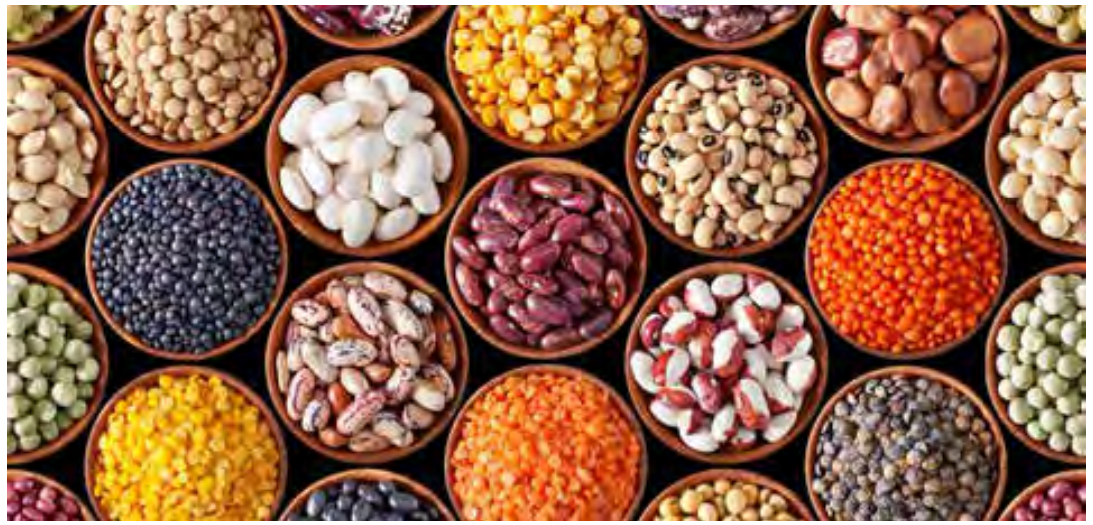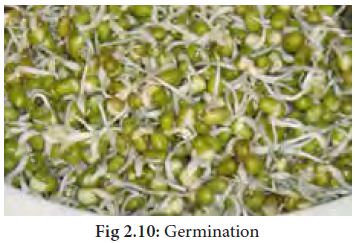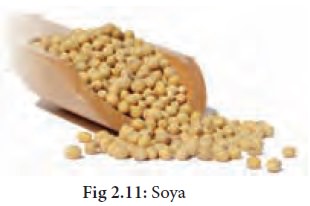Nutritive value, Toxic constituents in pulses, Germination, Forms, Role, Health benefits of pulses - Pulses | 11th Nutrition and Dietetics : Chapter 2 : Cereals and Pulses
Chapter: 11th Nutrition and Dietetics : Chapter 2 : Cereals and Pulses
Pulses

Pulses
Pulses are edible fruits or seeds of pod bearing plants. Pulses are the edible seeds of plants in the legume family. Pulses grow in pods and come in a variety of shapes, sizes and colors. Different varieties of pulses are grown around the globe. The major pulses or dhals which find important place in Indian diet are red gram dhal, Bengal gram dhal, black gram dhal and green gram dhal. Some pulses like Bengal gram, green gram, rajmah, soya bean dry peas are used as whole grams. A legume is a plant or its fruit or seed. Well known legumes include chickpeas, channa and soyabean.
Nutritive value of pulses
Pulses give 340
calories per 100 grams which is almost similar to cereal calorie value. Pulses
contain 55 to 60 percent starch. In a vegetarian diet, pulses are important
sources of protein. They give about 20-25 percent protein that is double the
amount of protein compared to cereals. The proteins of pulses are not of good
quality as they are deficient in aminoacids. Pulses contain
1.5 percent fats. They contain calcium, magnesium, zinc, iron, potassium and phosphorus. They are excellent sources of B complex vitamins particularly, thiamine, folic acid and pantothenic acid. Like cereals, they do not contain any vitamin A or vitamin C, but germinated pulses contain vitamin C.
Germination
Whole pulses are soaked
overnight, water should be drained away and the seeds should be tied in a
loosely woven cloth and hung. Water should be sprinkled twice or thrice in a
day. In a day or two, germination takes place.

Advantages of germination
·
Nutritive value is improved during sprouting. During sprouting,
minerals like calcium, zinc and iron are released from bound form. Vitamin C is
synthesised during germination.
·
Sprouting decreases cooking time.
·
Thickening power of starch is reduced due to conversion of starch
to sugars.
·
Germination improves taste and texture.
·
Germinated pulses add variety to the diet.
Toxic constituents in pulses
Some pulses contain chemical constituents that have toxic properties.
1. Trypsin inhibitors: They
are present in red gram, Bengal gram, cowpea, double bean, soyabean and dry
peas. Trypsin inhibitors are proteins that inhibit the activity of trypsin in
the gut and interfere with digestibility of dietary proteins and reduce their
utilisation.
2. Lathyrogens: Lathyrism
is a nervous disease that cripples man. It is known to result from an excessive
consumption of the pulse kesari dhal (Lathyrissativus). The symptoms of
lathyrism are muscular rigidity, weakness and paralysis of the leg muscle.
3. Haemagglutinins: These
are proteins in nature and they occur widely in leguminous seeds.
Haemagglutinins reduce the food intake resulting in poor growth.
4. Saponins: These are present in
soyabeans, Saponoins cause nausea and vomiting. These toxins can be eliminated
by soaking prior to cooking
5. Goitrogens: These substances
interfere with iodine uptake by thyroid gland. They are present in soyabean and
groundnuts. Excessive intake of these foods may lead to precipitation of
goitre.
6. Tannins: They have high amount of
seed coat in most legumes. Tannins bind with iron irreversibly and interfere
with iron absorption. Tannins also bind proteins and reduce their availability.
These toxic constituents can be removed during processing and
cooking.
Forms of pulses
Pulses are used in
different forms such
as:
·
Whole legumes
·
Decuticled split legumes with and without skin
·
Germinated or fermented pulses
·
Flour of pulses and
·
Parched pulses like Bengal gram and peas.
Soyabean
Soyabean with its high
protein contents is considered as a substitute for meat protein which is expensive.
Soyabean has 42 grams of protein per 100 grams of the product.
Soyabean can be
processed to obtain the following products:
1. Soya flour: Soya flour is used in
combination with wheat flour in preparation of chapathis. It can also be
incorporated in the batter used in the preparation of bajji, vadai and pakoda.

2. Soya milk: The milk is prepared
by grinding soaked beans with water. It is then passed through a mill in a
stream of water. The emulsion that is obtained is filtered and transferred to a
boiler and mixed with vitaminised margarine to which sugar, salt, calcium and
malt are added. The mixture is cooked for 20 minutes, emulsified and then
dried.
3. Tofu: It can be used like
paneer in various preparations.
4. Textured vegetable
protein (TVP): It is prepared using defatted soya flour from which most of the
oil and carbohydrates are removed. It is quick to cook with a protein content
compared to certain meats.
5. Soya protein isolates:
Soya protein isolates
are protein granules, isolated by processing. It is fortified with vitamins and
minerals and used as a complementary food.
6. Soya Grits: Soya grits are made
from lightly toasted soya beans that have been ground into coarse pieces. The
toasting brings out their pleasant, nutty flavor.
Role of pulses in cookery
1. Pulses are rich in protein and
vitamins B and improve the quality of cereal proteins.
2. Pulses give satiety due to high
protein and fibre content.
3. Pulses improve flavor and
consistencyof dhal sambhar and rasam.
4. They contribute to fermentation
in Idli and Dosai batter.
5. They are used in snacks like
sundal, bajji, etc.
6. They are used in salads, eg.
sprouted gram.
7. They are used in desserts like
dhal payasam and sweets like mysorepak and ladoos.
8. They are used as thickening
agents, eg. Bengal gram flour in gravies.
9. Roasted pulses are used in
chutneys and chutney powders.
10. They are used as seasonings and
curries.
Health benefits of pulses
Good for Your Heart: Pulses are high in
fiber and potassium which is useful in lowering blood pressure and reducing the
risk of heart diseases.
Lower Risk of
Diabetes: Pulses
are a low-glycemic index food. Including pulses in the diet can make it easier
to manage the blood sugar.
High in Protein: Pulses also make a
healthy and inexpensive source of protein.
Good Source of Folate:
Pulses also are a good
source of folic acid, a B vitamin needed to produce and maintain new cells.
Pulses can help
maintain and lose weight: The fibre in pulses increase the satiety value and helps in
reducing and maintaining weight.
Related Topics